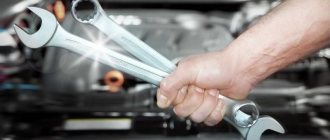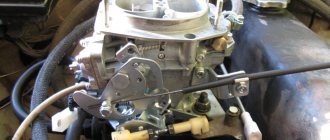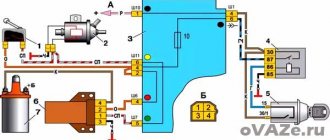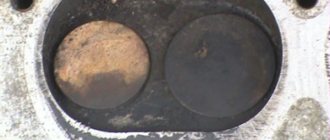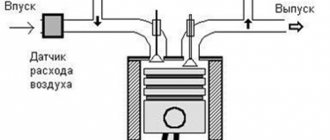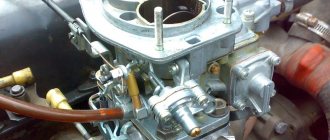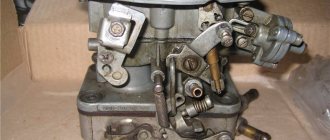Design and principle of operation of the solenoid valve
The solenoid valve, also called the forced idle economizer (IAF), is an integral component of any carburetor in modern cars. The active use of this unit began in the 80s of the last century, when the “battle” between injection and carburetor units intensified. This is largely due to the fact that the former had noticeably lower fuel consumption, and this already captivated a larger number of motorists.
In order to minimize the consumption of carburetor engines, automotive engineers began to actively electronize them. In a few words, the essence of the latter was to reduce fuel consumption through the use of electronic devices. As a result, electronization resulted in the appearance of a carburetor solenoid valve, as well as a number of other electrical devices in the design of this unit. But why was this necessary and how did it help the competition between carburetor engines and injection engines? In order to answer this question, it is worth paying attention to the operating principle of the EPH.
So, the carburetor solenoid valve is a device that runs on electric current and performs very specific functions. More precisely, it works to organize stable and optimal idle speed in the so-called forced mode of engine operation. The essence of the optimization is that when the engine operates in modes that do not require fuel consumption (switching to a lower gear, coasting, etc.), the EPHH turns off its supply without involving the throttle valve in the movement at all. This happens by transferring fuel through special channels at idle. During this transportation, only the idle jets, valves and some paths in the carburetor function, that is, its chambers and throttle valve are completely inactive.
As a result, we succeed:
- firstly, save fuel when the engine operates in the previously noted forced running mode;
- secondly, organize a stable and optimized idle speed;
- thirdly, to ensure high-quality and problem-free engine warming up for the driver during startup (by increasing the fuel supply with the same EPH);
- fourthly, eliminate unnecessary functioning of the throttle valve and a number of other components in the carburetor;
- and fifthly, optimize the operation of the entire motor, which significantly extends its service life.
Note that the economizer operates under the control of a special unit called the “carburetor solenoid valve control unit.” This device constantly analyzes the operation of the motor, based on sensor readings (speed, engine temperature, etc.), after which it gives appropriate instructions directly to the EPHH, and it, in turn, through the movement of the rod (small needle) either closes to the desired position fuel supply channels at idle, or vice versa, opens them. In general, there are no particular difficulties in a working economizer, which is clearly shown by the description of the device presented above. For even greater clarity of everything described, we recommend that you familiarize yourself with the following pictures:
Connection diagram for a typical EPHH:
Operating principle of the valve together with the control unit:
Symptoms of a problem
There are several main signs indicating failure of the EPHH:
- The engine regularly stalls at idle;
- Detonation occurs in the engine when the ignition is turned off;
- The engine stalls when coasting braking is performed.
You can check whether the EPHH and its control unit are working correctly with your own hands. To check the valve, you should monitor its activation in various operating modes. Correct operation is determined by ear or using a voltmeter.
Correct installation of the EM valve
It would seem, well, what’s so difficult, I screwed the valve into the carburetor and that’s it, but there are some nuances unknown to many, so if you do the installation yourself, without following them, you get new problems. So:
- It is extremely important to correctly screw the EMC onto the carburetor
- The most popular misconception is that it can only be tightened by hand.
- Moreover, this can be heard not only from a beginner, but also from middle-aged and very experienced specialists in reputable car services
- After such a recommendation, you and other drivers are in the deepest misconception
- The point here is that a valve that is loosely tightened (by hand) begins to dangle in the thread, and a poorly squeezed rubber band adds additional air leakage, which leads to a lean mixture - just one of the common reasons for unstable speed
- A similarly erroneous technique was proposed in an article titled “Capricious Valve” in a magazine titled “Behind the Wheel”:
- Let the engine idle, while turning off the power supply to the valve
- We tighten it little by little until the combustible mixture normalizes and the speed increases; if the engine stalls, this means that the valve is tightened
- Then start the engine and check the operation of the valve by disconnecting and connecting the power supply
- The whole point here is that the engine will stall as soon as the end of the nozzle has just begun to enter its seat, but it has not yet reached the end
- This “wisest” recommendation is also complemented by: “If necessary, you can tighten the EMC by about one more turn.”
- Doing this is just dangerous - if you squeeze the EMC, you can ruin the XX jet, or ruin the seat for the jet, which is even worse, and if you break the thread located in the carburetor cover, then the cost of repair will skyrocket
Independent examination of the valve condition
A detailed check of the functioning of the needle is possible only after dismantling the element under test. You must first remove the air filter and the filter element housing itself. The switch is unscrewed with a regular open-end wrench 13, carefully removed from its seat, and the analog element that dispenses the amount of fuel is removed.
The range of actions for a full diagnosis is as follows:
- pre-prepared conductors are connected to the battery terminals;
- “plus” is connected to the terminal, and “minus” is connected to the body of the part;
- The device reacts after voltage is applied.
dampers The shut-off needle is unprecedentedly retracted into the device body in the presence of a potential difference and instantly returns to its original position - the device is subject to further operation.
By turning on the ignition and closing the VAZ 2109 solenoid valve to the carburetor (body to body), with a known working EPHH control system, it is easy to assess the suitability of the locking element. As a result of contact with the “ground”, the needle should go inside the body with a characteristic click. Experienced owners test a newly purchased switch in this way.
- before screwing the device back in, the fuel nozzle should be washed/blown out;
- if the precision holes are heavily soiled, it is necessary to clean them with a fishing line or a soft wood needle;
- a loose valve may make it impossible to start the engine when the crankshaft is rotating;
- When tightening the element, you should not apply great forces, leading to deformation of the actuators of the part.
Briefly about the main thing
The solenoid valve stops fuel supply when the accelerator pedal is released and the crankshaft speed is more than 2,100 rpm, and resumes fuel supply at a frequency of less than 1,900 rpm under the same conditions. A faulty switch will prevent the engine from starting or will deliberately stop it from running.
There are several ways to check the serviceability of the solenoid valve on the carburetor of a VAZ 2109 car:
- connect standard or bypass power to the element output - a click should sound;
- remove the standard wire from the device with the engine running - the engine will stall;
- dismantle the sensor, connect it to the standard circuit and lean it against the carburetor - the needle will retract with a characteristic click;
- Connect the dismantled sensor to the battery: the needle should retract freely when voltage is applied and extend when there is no voltage.
CAPACIOUS VALVE
The editorial mail contained several letters, the authors of which asked to continue the conversation about malfunctions of carburetors, in particular Solex.
Eduard KONOP. Drawing by the author
Many people consider the Solex type carburetor to be quite reliable. Thus, the most important element of the carburetor is the needle valve, on which the stability of the characteristics largely depends; it fails much less often than on the Ozone. But Solex is also not immune to malfunctions. Let us remember one of the most important rules for a carburetor: if any jet is installed on a thread in the body, then it must be screwed tightly - all the way, without any loosening! And if the jet is lost, attempts to adjust this or that system (for example, idle speed) are pointless. This, however, applies to any elements of the carburetor - there are no “extra” parts in it.
Solenoid valve for carburetor VAZ 21083
- We guarantee fast processing of your order during business hours (we work from 11-00 to 20-00, Saturday and Sunday are days off).
- We guarantee reliable packaging of your order (when sending it by Russian Post or transport company).
- We guarantee the fastest possible dispatch of your paid order (within 2-4 business days after receipt of payment).
- We guarantee a refund or exchange for another product (with recalculation) within 14 days from the date of receipt of the order (the product must be in good condition, without traces of installation, delivery costs are not reimbursed).
- We guarantee a free exchange of goods (transportation costs at our expense) if the purchased goods turn out to be defective.
Payment Methods
Delivery in Russia and abroad
Pickup in Moscow
- Description
- Reviews
APPLICABILITY: VAZ 2108, 2109, 21099, VAZ 2110, 2111, VAZ 2115, VAZ 21213, 2131 (Niva) with a carburetor engine.
Standard solenoid valve for any SOLEX carburetor.
The presence or absence of idle speed on carburetor engines of VAZ cars often depends on the serviceability of the carburetor solenoid valve. If you have any problems with the engine idle speed, the first thing to check is the solenoid valve.
The verification is carried out in 4 stages:
1
. Turn on the ignition, but do not start the engine.
2
. Remove the tip of the wire from the output of the solenoid valve (Thus, de-energize it. The shut-off needle is in the forward position and blocks the hole for supplying the fuel mixture to the idle system).
3
. Place the tip of the wire on the terminal of the solenoid valve (Apply voltage. A click should be heard. The shut-off needle is retracted into the valve body and opens the fuel supply hole to the idle system).
4
. We connect a piece of wire between the plus of the battery and the terminal of the solenoid valve (A click appears - the electrical circuit is faulty. There is no click - the valve needs to be replaced).
Principle of operation and symptoms of failure of control equipment
The immediate task of the electromagnetic valve installed in the carburetor of the VAZ 2109 engine is to stop the fuel supply in “inertial” modes:
- engine braking;
- movement downhill;
- gear shift.
The electromagnetic switch is an integral element of the forced idle economizer and executes commands from the control electronics. The EPHH device is programmed according to the following algorithm:
- when the crankshaft rotation speed is more than 2,100 rpm and the gas pedal is released, the actuator is turned off, the needle closes the holes, fuel is not supplied;
- upon reaching 1,900 rpm, the device turns on, the needle retracts and the fuel begins to move through the channels.
Carburetor solenoid valve - how does it work?
- Carburetor solenoid valve - how does it work?
- 1. What causes excessive consumption of gasoline?
- 2. What does a carburetor solenoid valve do?
- 3. How does the solenoid valve of the VAZ 2107 work?
Carburetor engines are a type of internal combustion engine. These engines have external mixture formation and autonomous ignition. In an engine of this type itself, a ready-made air-fuel mixture will be sent to its cylinders, which is prepared in the carburetor device, which is why, in fact, such an engine received the name of the same name. In addition, such a procurement process can occur through fuel injection, in a gas-air mixer, etc.
- 1. What causes excessive consumption of gasoline?
- 2. What does a carburetor solenoid valve do?
- 3. How does the solenoid valve of the VAZ 2107 work?
Regardless of the method of formation of the mixture, as well as the number of strokes into which the working cycle is divided, a carburetor engine has one single operating principle. The directly combustible mixture, which is compressed in the combustion chamber, is ignited by the ignition system at a certain moment, often through an electric spark system. In addition, ignition from a glow tube can be used, which in modern times is found in small-sized internal combustion engines. Currently, plasma and laser ignition are also used, albeit at an experimental level.
Electrical voltage is applied directly to the solenoid coil of the valve, as a result of which the magnetic core begins to be drawn into the solenoid. This procedure will close or open the system valve. The core itself moves inside the solenoid coil tube, which is necessary to increase the sealing component of the solenoid valve. This device is similar to a conventional shut-off valve. The only difference is that in such a device, closing and opening the valve does not use any mechanical force, since it occurs through an electromagnetic coil by applying electrical voltage to it.
What is a starting enrichment
A starting enricher (electrovalve) is a device designed to supply an additional amount of air-fuel mixture into the combustion chamber during a cold start of the scooter engine. The fact is that when starting the scooter when cold, the engine requires an enriched mixture. The supply of such a mixture is ensured by the carburetor solenoid valve . If the starting enrichment is in good working order and there are no breakdowns in other engine elements, the scooter engine starts easily even at temperatures around zero degrees.
